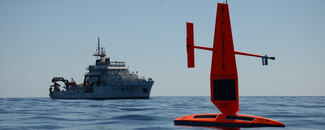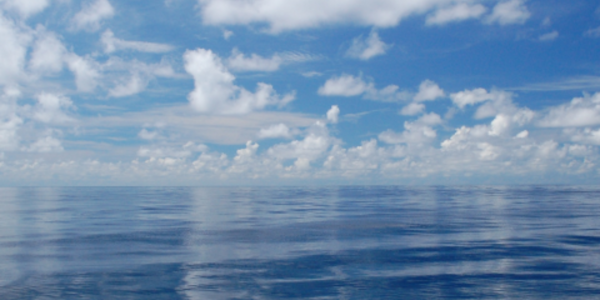Uncrewed Marine Systems bring opportunities for data synthesis

The age of Uncrewed Maritime Systems (UMS) is here. NOAA’s current use of UMS is improving performance in lifesaving and economically impactful missions and is setting the course to strengthen environmental science and technology leadership for the coming decades. With the increase in uncrewed ocean observing capabilities, NCEI has received an associated increase in the amount of data collected by UMS. NCEI is working to effectively steward UMS data including integrating the data into publicly available, synthesized products.
Emerging technologies
Uncrewed Maritime Systems are defined as waterborne systems (vehicles, sensors, communications software) that can perform an ocean observing mission without human input. UMS include Uncrewed Underwater Vehicles (UUVs) - untethered systems capable of autonomous submerged operation; and Uncrewed Surface Vehicles (USVs) - untethered, self-propelled surface crafts ranging in size from human-portable systems to small boat-size vessels that are capable of autonomous, semi-autonomous, or remote-controlled operations.
Ocean observations from these non-traditional platforms are a recent addition to the NCEI archive collection and NCEI synthesized products. UMS produce a variety of different types of data which are typically collected simultaneously. Implementation of a coordinated UMS Data Enterprise is an important component of the NOAA Uncrewed Systems Strategy.
Data archive volumes at NCEI have greatly increased in recent years as have the requests from users for that data. NCEI’s scientific data analysts apply subject matter expertise in long-term data preservation and management. In addition, NCEI extracts the data from different individual data archive packages and integrates them into synthesized, referential data products to improve the user experience. These products range from data-type specific databases like the Surface Underway Marine Database and the World Ocean Database to analysis (value-added) products such as climatological mean fields and ocean time series of variables such as ocean heat and oxygen content.
Rapid Expansion
The NCEI Surface Underway Marine Database (SUMD) is one of NCEI’s new foundational synthesized data products. SUMD is a global, comprehensive dataset of quality-controlled near real-time in-situ ocean surface underway data. The database consists of data from over 490 vessels and uncrewed surface vehicles from 1986 to the present. All data were processed using the same 11-step quality control procedures and criteria and flagged using a two-level system to provide a well-organized, uniformly quality-controlled dataset for the user community.
The database was originally developed to facilitate understanding and access to a set of quality-controlled in-situ sea surface temperature (SST) and salinity (SSS) measurements collected by thermosalinographs (TSG). The database was later expanded to include surface underway non-TSG data, such as meteorological data from the vessel-mounted meteorological packages, microplastics data and data from 23 uncrewed surface vehicles, such as Saildrones and Wave Gliders.
Leveraging the Data
SUMD serves as a significant resource for establishing matchups with satellite ocean surface salinity for validation and evaluation. Due to the high resolution of in-situ data, these matchups may prove to be more informative than single observed data points. Underway data can provide continuous fine-scale observations to capture the spatial variations of the surface ocean (e.g. ocean fronts, river plumes etc.). Moreover, about 50% of the SUMD data were collected in the coastal regions with depth less than 1000m where the variation of the SSS and temperature is larger and faster compared to open oceans. Satellite observations are usually more erroneous in the coastal regions. Coastal regions have more economic influences on the Blue Economy, such as tourism, fishing and aquaculture than the open oceans. SUMD becomes a critical and most reliable source for SSS research, particularly in the coastal regions.
SUMD is also one of the sources for the NOAA National Centers for Environmental Prediction (NCEP) climate models and products. NCEI will incorporate the SUMD data into the International Comprehensive Ocean-Atmosphere Data Set (ICOADS), which is the primary data source for the Optimum Interpolation Sea Surface Temperature (OISST) and the Extended Reconstructed Sea Surface Temperature (ERSST). Both SST products provide monthly SST fields for climate change and global warming research. SST and SSS from SUMD are needed to improve our knowledge of Earth’s water cycle and climate and have proven to be valuable for describing climate variability at seasonal to decadal time scales, improving estimates of evaporation and precipitation (E-P) budgets, and assessing numerical model performances.
Reference: S. Mesick, Z. Wang, A. Mishonov, T. Boyer and H. -m. Zhang, "Incorporating Discrete Unmanned Maritime System Data Collections Into NCEI Synthesized Data Products," Global Oceans 2020: Singapore – U.S. Gulf Coast, 2020, pp. 1-8, doi: 10.1109/IEEECONF38699.2020.9389421.



